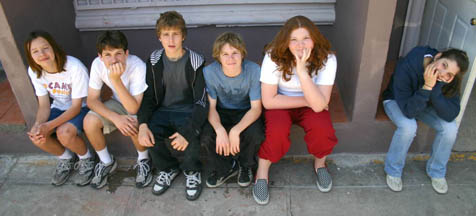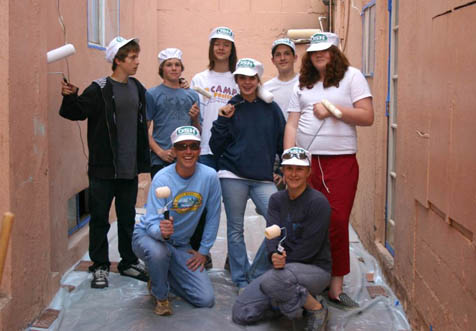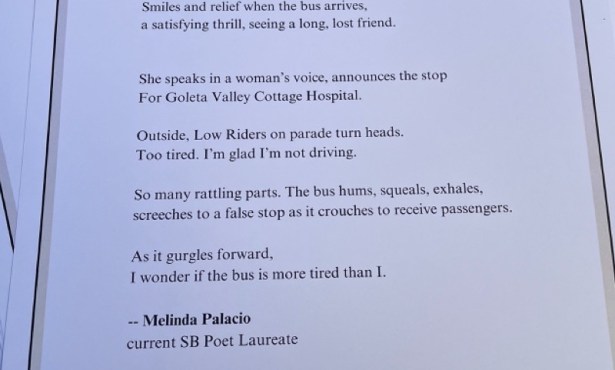24 Hours in Tijuana
Leading a S.B. Youth Group Across the Border and Back
At 5 a.m. the next morning I was standing in my kitchen, a towel on my head, wondering vaguely how a teenage girl had materialized in my house before sunrise, and trying to remember whether teenagers drank coffee, or whether I should offer her tea instead. By the time Angie and I got behind the wheel of my car, the caffeine had begun to kick in, and we headed over to the Unitarian Society of Santa Barbara to meet up with the rest of the team: the five other 8th-grade members of the Coming of Age program, and my co-leader, Kir.

Half an hour later, buckets of rollers and brushes onboard, water bottles distributed, and sleeping bags packed, we were set to depart. Then the last-minute document check turned up two missing birth certificates, and after a series of frantic phone calls to parents on vacation in Arkansas and sleepy teenage brothers, a couple of cross-town trips, and some early-morning rummaging through file cabinets, we finally hit the road for a weekend in TJ.
The plan had been to meet Sara Gomez, the director of Tijuana Christian Mission (TCM), in San Ysidro, California, and follow her across the border to the orphanage, where we’d spend the afternoon painting, stay overnight, and get up early the next morning to buy and distribute rice and beans to those who could use them. As it happened, Sara sent her mother, Martha, founder and director of TCM, in her place. We met Martha in a parking lot just a couple of exits from the Mexican border, and followed her minivan past the border patrol, the racks of Raiders shirts and synthetic blankets, miniature guitars and woven ponchos, and out onto the highway. The giggling and backseat banter that had lasted all the way down the California coast had suddenly stopped, and I turned around to see Molly and Halen in the seat behind me, staring out the windows in silence as their first visions of Tijuana flew past. “Why’s everyone so quiet?” Molly asked me nervously. “I think they’re just soaking it in,” I told her.
Our arrival at the orphanage seemed to break a barrier. Jesse, a veteran orphanage worker, handyman, and self-appointed welcome team, came forward to shake everyone’s hand. “¿C³mo est¡s?” he greeted us in turn, grinning robustly. Noah discovered the resident puppy litter, and soon Sara’s sister Susie came out to say hello and direct us toward the breezeway that needed painting. By early afternoon, we were hard at work, the high school- and college-aged residents of the orphanage politely making their way past us, going in and out of their dormitory rooms. The younger children, Susie explained, had been relocated to a new building outside Rosarito in order to be closer to the elementary school. The change marked the orphanage’s first move since its founding 43 years ago.

After dinner, Susie invited our group to join the residents for a “youth meeting,” which turned out to be a combination rock concert, bible study, and raucous playtime. The Coming of Age teenagers, more accustomed to camping trips and personal sharing than to electric guitar and amplified scripture, were at once shy and fascinated. Forrest balked at Dewey’s emphatic encouragements to stand up and sing in front of 50 strangers, but by the end of the night, the six had spread themselves throughout the room, holding hands with the orphanage residents as one young woman led a closing prayer.
After the meeting, a group of teens grabbed a basketball and started shooting hoops in the orphanage’s inner courtyard, and the Santa Barbara group jumped at the chance for some non-linguistic interaction. We slept that night on the tile floor of an upstairs room, the lights of Tijuana casting an orange glow through the windows.
The next morning, we were out of bed and seated in the central dining hall, where 100-pound sacks of pinto beans and rice were ready for packing into small plastic bags. The team formed two human conveyer belts, and two piles of bags, dubbed by Dewey “Mount Everrice” and “Mount Beanicus,” grew beside them. Once ready, we piled into the Coming of Age minivan and headed out, following Jesse’s pickup truck through the city and out toward the dump. We parked beside the cemetery and filled our arms and pockets with our bounty. Susie and Jesse pointed us toward the muddy, rutted streets of the community perched on the hillside, where dump-workers lived in homes of concrete, stucco, and corrugated aluminum siding. “Can I walk with you?” Molly asked me, uncharacteristically subdued. “Come on,” I told her, realizing that my confident authority as a youth group leader was quietly taking a major humility check. Together, Molly and I walked uphill into this makeshift village, speaking in broken Spanish to the people standing in the streets and working in their front yards. “Buenos d-as, Se±or,” we volunteered again and again. “Quiero frijoles y arroz?” Every time, the small, weighty packages were lifted from our fingers, sometimes with a smile or a “gracias,” sometimes in something more like stunned silence. In what seemed like less than five minutes, 200 pounds of food had vanished, and we stood with empty pillow cases and empty pockets, wishing we had brought 10 times more. And then, slowly, we made our way back to the van.
There wasn’t a lot of talking on the way back to the orphanage, or as we said our goodbyes to Jesse and Susie and headed back to the border. As we waited in the two-hour line of stop-and-go traffic, Angie asked, “How come the cars waiting to go back to America are all so big and clean and new?” “I just don’t understand,” Molly chimed in. “How can it be so different here when America is right there?”
Neither Kir nor I provided any satisfying answers. But back in Santa Barbara that evening, reuniting the teens with their families and sending them off to their hot showers and soft beds, I was glad they were asking questions.
4•1•1
For more information about Tijuana Christian Mission, call Sara Gomez, mission trip coordinator, at (619) 428-4638, or visit tijuanachristianmission.org. For info about the Coming of Age program at the Unitarian Society of Santa Barbara, call 965-4583 or visit ussb.org.



